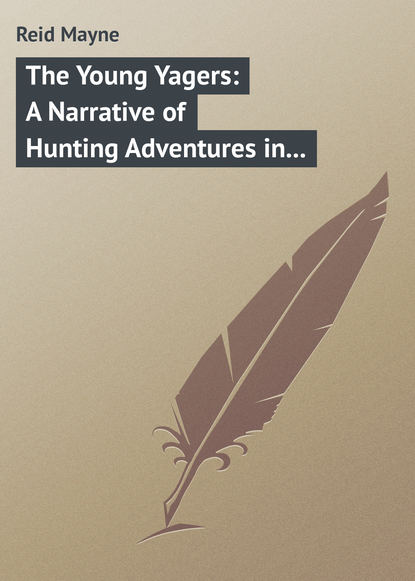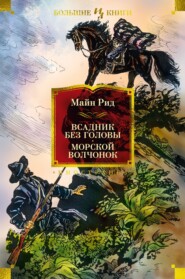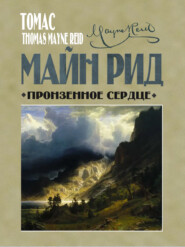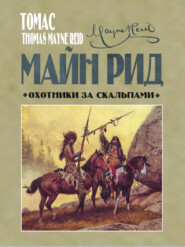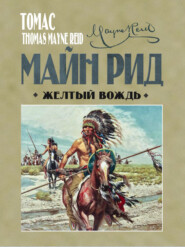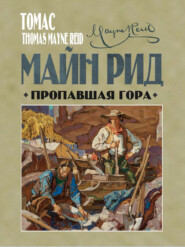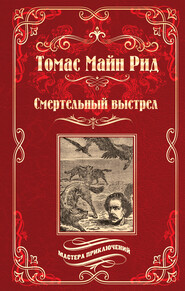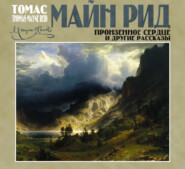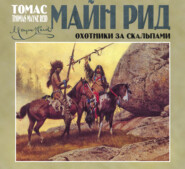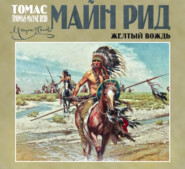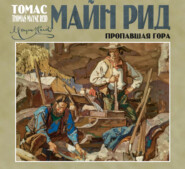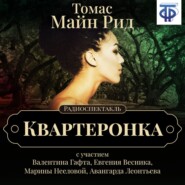По всем вопросам обращайтесь на: info@litportal.ru
(©) 2003-2024.
✖
The Young Yagers: A Narrative of Hunting Adventures in Southern Africa
Настройки чтения
Размер шрифта
Высота строк
Поля
The blade of the assegai still remained in the flesh, but the lioness waited no longer. She had now perceived her enemy; and, uttering a vengeful scream, she sprang towards him. With one tremendous bound she cleared three-fourths of the space that lay between them, and a second would have carried her upon the shoulders of the Kaffir; but the latter was prepared to receive her, and, as she rose to her second leap, he disappeared suddenly from the scene! As if by magic he had vanished; and had not the boys been watching his every movement, they would have been at a loss to know what had become of him. But they knew that under that oval convex form, whose edges rested upon the earth, lay Congo the Kaffir. There lay he, like a tortoise in its shell, clutching the straps with all his might, and pressing his carapace firmly against the ground!
The lioness was more astonished than the spectators. At the second leap she pitched right down upon the shield, but the drum-like noise made by her weight, and the hard firm substance encountered by her claws, quite disconcerted her, and springing aside she stood gazing at the odd object with looks of alarm!
She stood but for a moment, and then, uttering a savage growl of disappointment, turned tail upon it, and trotted off!
This growl guided Congo. The shield was raised from the ground – only on one side, and but a very little way at first – just enough to enable the hunter to see the stern of the retreating lioness.
Then the Kaffir rose quickly to his feet, and, holding the shield erect, prepared for the casting of a second assegai.
This was quickly thrown and pierced the animal in the flank, where shaft and all remained sticking in the flesh. The lioness turned with redoubled fury, once more charged upon her assailant, and, as before, was met by the hard convex surface of the shield. This time she did not immediately retreat, but stood menacing the strange object, striking it with her clawed hoofs, and endeavouring to turn it over.
Now was the moment of peril for Congo. Had the lioness succeeded in making a capsize, it would have been all up with him, poor fellow! But he knew the danger, and with one hand clutching the leathern straps, and the other bearing upon the edge of the frame, he was able to hold firm and close, – closer even “than a barnacle to a ship’s copper.”
After venting her rage in several impotent attempts to break or overturn the carapace, the lioness at length went growling away towards her former position.
Her growls, as before, guided the actions of Congo. He was soon upon his feet, another assegai whistled through the air, and pierced through the neck of the lioness.
But, as before, the wound was not fatal, and the animal, now enraged to a frenzy, charged once more upon her assailant. So rapid was her advance that it was with great difficulty Congo got under cover. A moment later, and his ruse would have failed, for the claws of the lion rattled upon the shield as it descended.
He succeeded, however, in planting himself firmly, and was once more safe under the thick buffalo hide. The lioness now howled with disappointed rage; and after spending some minutes in fruitless endeavours to upset the shield, she once more desisted. This time, however, instead of going away, the angry brute kept pacing round and round, and at length lay down within three feet of the spot. Congo was besieged!
The boys saw at a glance that Congo was a captive. The look of the lioness told them this. Though she was several hundred yards off, they could see that she wore an air of determination, and was not likely to depart from the spot without having her revenge. There could be no question about it, – the Kaffir was in “a scrape.”
Should the lioness remain, how was he to get out of it? He could not escape by any means. To raise the shield would be to tempt the fierce brute upon him. Nothing could be plainer than that. The boys shouted aloud to warn him of his danger. They feared that he might not be aware of the close proximity of his enemy.
Notwithstanding the danger there was something ludicrous in the situation in which the Kaffir was placed; and the young hunters, though anxious about the result, could scarce keep from laughter, as they looked forth upon the plain.
There lay the lioness within three feet of the shield, regarding it with fixed and glaring eyes, and at intervals uttering her savage growls. There lay the oval form, with Congo beneath, motionless and silent. A strange pair of adversaries, indeed!
Long time the lioness kept her close vigil, scarce moving her body from its crouching attitude. Her tail only vibrated from side to side, and the muscles of her jaws quivered with subdued rage. The boys shouted repeatedly to warn Congo; though no reply came from the hollow interior of the carapace. They might have spared their breath. The cunning Kaffir knew as well as they the position of his enemy. Her growls, as well as her loud breathing, kept him admonished of her whereabouts; and he well understood how to act under the circumstances.
For a full half-hour this singular scene continued; and as the lioness showed no signs of deserting her post, the young yägers at length determined upon an attack, or, at all events, a feint that would draw her off.
It was close upon sunset, and should night come down what would become of Congo? In the darkness he might be destroyed. He might relax his watchfulness, – he might go to sleep, and then his relentless enemy would have the advantage.
Something must be done to release him from his narrow prison, – and at once.
They had saddled and mounted their horses, and were about to ride forth, when the sharp-eyed Hans noticed that the lioness was much farther off from the shield than when he last looked that way. And yet she had not moved, – at all events, no one had seen her stir – and she was still in the very same attitude! How then?
“Ha! look yonder! the shield is moving!”
As Hans uttered these words the eyes of all turned suddenly upon the carapace.
Sure enough, it was moving. Slowly and gradually it seemed to glide along the ground, like a huge tortoise, though its edges remained close to the surface. Although impelled by no visible power, all understood what this motion meant, – Congo was the moving power!
The yägers held their bridles firm, and sat watching with breathless interest.
In a few minutes more the shield had moved full ten paces from the crouching lioness. The latter seemed not to notice this change in the relative position of herself and her cunning adversary. If she did, she beheld it rather with feelings of curiosity or wonder than otherwise. At all events, she kept her post until the curious object had gone a wide distance from her.
She might not have suffered it to go much farther; but it was now far enough for her adversary’s purpose, for the shield suddenly became erect, and the Kaffir once more sent his assegai whirring from his hand.
It was the fatal shaft. The lioness chanced to be crouching broadside towards the hunter. His aim was true, and the barbed iron pierced through her heart. A sharp growl, that was soon stifled, – a short despairing struggle, that soon ended, and the mighty brute lay motionless in the dust!
A loud “hurrah!” came from the direction of the camp, and the young yägers now galloped forth upon the plain, and congratulated Congo upon the successful result of his perilous conflict.
The group of dead bodies was approached, and there a new surprise awaited the hunters. The lion was dead, as they had long since conjectured, – the sharp horns of the oryx had done the work; but what astonished all of them was, that the horns that had impaled the body of the great lion still remained sticking in his side. The oryx had been unable to extricate them, and would thus have perished along with her victim, even had the lioness not arrived to give the fatal blow!
This, both Congo and Swartboy assured the party, was no uncommon occurrence, and the bodies of the lion and gemsbok are often found upon the plains locked in this fatal embrace!
The cow gemsbok, yielding the more tender venison, was soon skinned and cut up; and as the delicious steaks spurted over the red coals of their camp-fire, the young yägers became very merry, and laughed at the singular incidents of the day.
Chapter Eight.
A Short Chat about Lions
Before going to supper the hunters dragged the carcasses of both lion and lioness close up to the camp-fire. A good pull it was, but they managed it by attaching strong “rheims” of raw hide around the necks of the creatures, and sliding them with the grain of the hair.
Their object in bringing them to the fire was, that they might have light to skin them, – not that they deem the lion-hides of any great value, except as trophies of their expedition – and they were not going to leave such trophies on the plain. Had the lions been permitted to remain all night where they had been killed, the hyenas would have eaten them up before morning, – skins and all. It is a fable which tells that the hyena will not eat the dead lion. The filthy brute will eat anything, even one of his own kind, – perhaps the most unpalatable morsel he could well find.
Of course the oryx were also brought up to the camp to be skinned and cut up. The bull, as large and heavy as a dead ass, gave them a good pull for it. But it afforded Groot Willem an opportunity of exhibiting his enormous strength; and the big boy, seizing the tow-rope, dragged the oryx after him with as much ease as if it had been a kitten at the end of a string of twine.
Both the gemsboks were regularly “butchered” and cut into quarters, to be carried to the next camp, and there dried. They would have dried the meat on the spot, but the water where they had halted was not good, and they did not wish to remain there another day.
The horns of the oryx are also esteemed trophies of the chase, and those of both that were killed being perfect specimens – long, handsomely ringed, and black as ebony – were added to the collection which the young yägers were forming, and stowed safely away in the wagons. The heads, with the skins left on, were carefully cleaned and preserved, at no distant day to become ornaments in the voor-huis, or entrance-hall, either of the Von Bloom or Van Wyk mansions.
All these matters being arranged, the yägers sat down to supper around the camp-fire. The roast ribs and steaks of the gemsbok venison proved delicious, and the whole party, as already stated, were contented and merry. Of course lions were the subject of conversation, and all laughed again and again whenever they thought of Congo and his encounter.
All of them, little Jan and Klaas excepted, had stories to tell of adventures with lions, for these animals were still to be found in the Graaf Reinet, and both Groot Willem and Arend had been present at more than one lion-hunt. Hans and Hendrik had met them in many an encounter during the great elephant expedition, and Swartboy was an old Hottentot lion-hunter.
But Congo seemed to know more of the lion than even Swartboy, though the latter would have gone wild had such a thing been hinted at by any one of the party; and many a rival story of strange interest fell from the lips of both Kaffir and Bushman at that same camp-fire. Some of the party had heard of a mode of lion-hunting practised by the Bechuana tribes, and, indeed, in Congo’s own country. There was nothing very novel about the mode. A number of people, – naked savages they were, – attacked the lion wherever they met him, either in the bush or on the open plain, and there fought him to the death. These people carried for arms only the assegai, and, as a sort of defensive weapon, a mop of black ostrich-feathers fastened upon the end of a slender stick, and somewhat resembling a large fly-brush. The object of this was to disconcert the lion when rushing upon the hunter. By sticking it in the ground at the right moment, the lion mistakes the clump of ostrich-feathers for his real assailant, and, charging upon it, permits the hunter to escape. Such a ruse is far inferior to the trick of the carapace, but that singular mode of defence against the lion was only practised by such cunning hunters as Congo.
Now, as already stated, the plan practised by the Bechuana savages had nothing very novel or strange in it. Any strangeness about it consisted in the fact of the imprudence of such a mode of attack; for it was said that the hunters did not stand off at a distance and cast their assegais, on the contrary, they retained these weapons in their hands, and used them as spears, approaching the lion close enough to thrust them into his body! The consequence was, that in every encounter with their terrible antagonist, several hunters were either killed or badly mangled. This was the thing that appeared strange to our young yägers. They could not understand why any hunters should attack the fierce lion thus boldly and recklessly, when they might avoid the encounter altogether! They could not understand why even savages should be so regardless of life. Was it true that any people hunted the lion in that way? They asked Congo if it was true. He replied that it was.
Now this required explanation, – and Congo was requested to give it, which he did as follows.
The hunters spoken of were not volunteers. They did not attack the lion of their own will and pleasure, but at the command of the tyrant that ruled them. It was so in Congo’s country, where the sanguinary monster, Chaaka, had sway. The whole people of Chaaka were his slaves, and he thought nothing of putting a thousand of them to death in a single morning to gratify some petty spleen or dislike! He had done so on more than one occasion, often adding torture. The tales of horrors practised by these African despots would be incredible were it not for the full clear testimony establishing their truth; and, although it forms no excuse for slavery, the contemplation of such a state of things in Africa lessens our disgust for the system of American bondage. Even the atrocious slave-trade, with all the horrors of the “middle passage,” appears mild in comparison with the sufferings endured by the subjects of such fearful tyrants as Chaaka, Dingaan, or Moselekatse!
Congo related to the young yägers that it was customary for Chaaka’s people to act as the herdsmen of his numerous flocks, and that when any of his cattle were killed by a lion, – a frequent occurrence, – the unfortunate creatures who herded them were commanded to hunt the lion, and bring in his head, or suffer death in case of failure; and this sentence was sure to be carried into effect.
This explained the apparently reckless conduct of the hunters.
Congo further stated that he had been compelled to take part in several of these lion-hunts, in each of which the lives of men were sacrificed. He spoke of one in particular where no less than ten hunters had been killed before the lion was captured; – captured, not killed, for on this occasion the despot had taken a whim into his head, and ordered the fierce animal to be taken alive! His command was, that if the lion were not brought before him alive, and without a wound or scratch, every man engaged in the hunt should suffer death! As the unfortunate hunters well knew the threat was no idle one, they caught the lion in their naked arms, and succeeded in tying him, but not until ten of their number had fallen victims to their involuntary zeal!
To these and other tales of lions did the young yägers listen as they sat around the blazing camp-fire.
Chapter Nine.
The Unicorn





